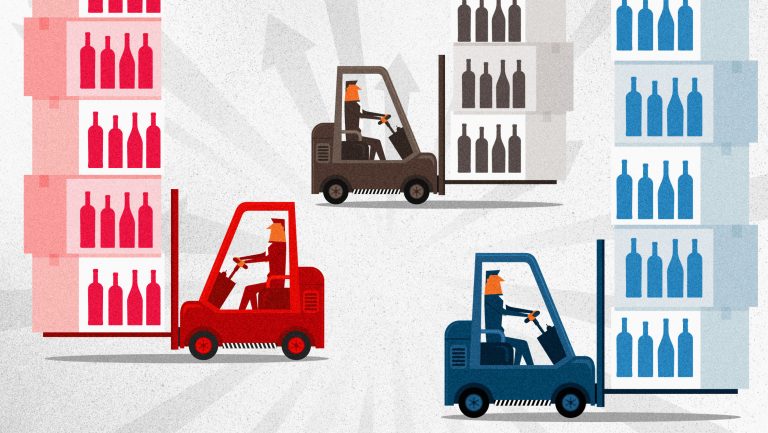The craft beverage phenomenon, along with the sheer amount of wines, beers, and spirits on the market, has changed many aspects of the U.S. alcohol business over the past decade. While the trend has mostly been a positive for the industry, it has also brought challenges, especially when it comes to distribution. Some importers have begun turning to multiple distributors in the same market, splitting their portfolios among several wholesalers.
There are a variety of reasons for this trend. Some importers are keeping older, more established brands at a primary distributor while enlisting the expertise of smaller distributors who specialize in craft beverages to sell newer brands. Others see breaking up their portfolio as the only way to get their entire portfolio to buyers because existing distributors can’t take on all of an importer’s new brands. Some simply use different distributors to reach different segments or channels of retail. But in a business that is very much about relationships, using multiple distributors can strain or even sever a relationship between an importer and a particular distributor. SevenFifty Daily spoke to importer and distributor experts to determine best practices for navigating this tricky new landscape.
Managing Relationships
“The importer’s portfolio gets bigger, the distributor’s portfolio gets bigger, but you still want to have the distributor’s attention,” says Nicolas Palazzi, the owner of PM Spirits, an import-distribution company in Brooklyn, New York, that specializes in rare, high-end products. “That’s going to be more difficult when you have 60 items and they’re already carrying 300 spirits. So it’s becoming more and more frequent that we’ll look at spreading the book. Not for the sake of adding more work … but just because of the fact that you want that attention.”

Don’t miss the latest drinks industry news and insights. Sign up for our award-winning newsletters and get insider intel, resources, and trends delivered to your inbox every week.
Victor Schwartz, the owner of the importer and distributor VOS Selections, based in New York City, thinks the overall trend of using a number of distributors in the same market makes sense given today’s environment. “It becomes a little bit more like a stock marketplace where everything will find its level,” he says, “everything will find its home.”
But Ronnie Sanders, the president of Vine Street Imports in Mount Laurel, New Jersey, says that working with multiple distributors can cause bruised egos. Sometimes distributors don’t like the idea of importers splitting their business with competitors. He experienced this firsthand with a distributor in Texas. “When we did go through another distributor,” says Sanders, “he got upset. We ultimately had to leave [that distributor].”
Such tension doesn’t surprise those who have been in the business for a while. “Distributors tend to regard brands kind of the way they do their [spouses], right?” says Ansley Coale, the CEO of Craft Distillers in Ukiah, California, a spirits marketing company that represents a number of imported brands. “I mean, if you mess with them, it’s really heavy-duty stuff. Because their worst nightmare is if they put a lot of effort into a brand and then it moves somewhere else.”
Maintaining Effective Communication
Experts say there are certain ways to navigate multiple-distributor relationships in the same market that can help streamline business—and keep relationships strong. Kate Palmer, the former regional assistant vice president of craft spirits at Horizon Beverage Group based in Norton, Massachusetts, will launch her own company, Hearts + Tales, this summer to offer distributor management, sales, marketing plans, and eventually, importing. “This whole business is so relationship driven,” she says. “It’s really about the relationship of the importer to the wholesaler and how they’re able to effectively communicate.”
Sanders explains that when Vine Street decided to use dual distributors in certain markets, he felt that the message from management to the sales team was critical. “If we decide to [use dual distributors] because a distributor only wants 8 out of 25 brands that we carry,” he says, “then that is the message that needs to be communicated. Likewise, if the distributor is underperforming and that is the reason we are ‘dualing,’ then that message needs to get told. We rarely will dual in markets where the distributor is optimizing our portfolio.”
Palmer adds that at the executive level, importers should never say that they have a preferred wholesaler, even if they do. “Each wholesale partner should be hand-selected to do the best job they can for each brand,” she says, “and the importer should feel confident explaining as much. Wholesalers always know their strengths and weaknesses in the market, even if they don’t want to admit the latter.”
The relationship between the importer and its different distributors also needs to be handled with sensitivity while in the presence of buyers. For example, if an importer is visiting an account with one of his distributor’s sales reps and the buyer asks about a brand the other distributor carries, it should be handled diplomatically. “The importer should very politely state, ‘I do represent brand X and would be happy to follow up with you about it, but today I’m focused on [these] brands with [this] distributor,'” says Palmer. “This will help build trust with the rep/wholesaler, which is priceless for the importer in this sort of situation.”
When the reasons for doing so are effectively communicated, spreading an importer’s book across multiple distributors may actually benefit all parties involved. “If someone comes to me,” says Schwartz, “and they’ve got a ginormous Spanish portfolio and I’m only interested in a couple of things, maybe it’s good that they go somewhere else and sell some of their products to other distributors out there. It reduces the amount of pressure on me to have to take everything that’s in their book.”

Becoming “The One”
Although importers may feel the need to work with multiple distributors to sell all of their products in a given market, many still prefer doing business with one distributor in each market, if possible. “Nobody wants two distributors in a single market because that just eats too much of your personnel’s time,” says Coale. “Working with a distributor is very time consuming.”
Since the ultimate goal of many importers is to eventually consolidate their book into one distribution house per market—if not in violation of any state franchise laws—this also gives distributors the opportunity, potentially, to work with an importer’s entire book. Palmer experienced just that, eventually getting the entire Craft Distillers portfolio to move to Horizon. “Origin [the craft division of Horizon] performed well on the [Craft Distillers] brands from the onset,” she says, noting that Horizon offered full state coverage for the larger brands as well as specialized sales for the smaller brands. The result proved a win-win for everyone involved.
Consumers are drawn to an increasingly diverse range of niche products, so managing relationships with distributors to handle all these new products will likely be a continuing challenge. But as Palazzi points out, the ultimate goal—whether using multiple distributors in the same market, or just one—is finding relationships that really click.
“The best situation is finding like-minded individuals who understand the products like you do, who care about the products, who care about you and what you represent,” he says. “Not only do they know they’re going to make money on your products, but they also have your best interests in mind—and that’s a good working relationship.”

Dispatch
Sign up for our award-winning newsletter
Don’t miss the latest drinks industry news and insights—delivered to your inbox every week.
Andrew Kaplan is a freelance writer based in New York City. He was managing editor of Beverage World magazine for 14 years and has worked for a variety of other food and beverage-related publications, and also newspapers. Follow him on Twitter at @andrewkap.







